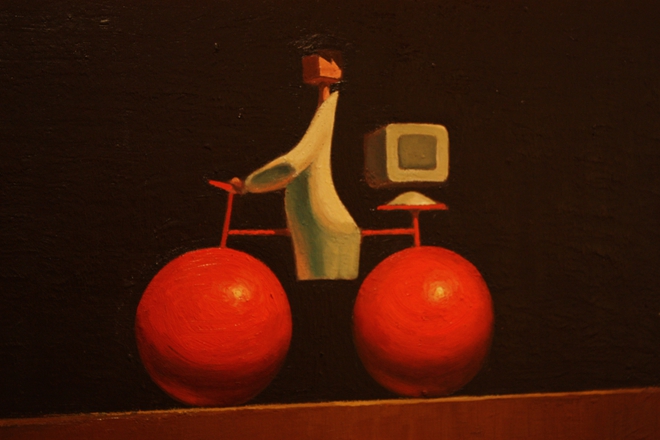Like last month’s auctions, ArtBasel Miami provided another highly anticipated stress test to an apparently recovered art market. The results indicate a strong and steady pulse, with sales exceeding the expectations of the somewhat humbled larger galleries. The common plan of attack seems to have been to bring the tried and true, and the result at the Miami Convention Center was a dizzying array of mini-blockbuster shows. Chinese contemporary art was a perfect example. The tendency to bring only the biggest and the best meant fewer artworks overall than in previous years and less risk-taking on emerging talent.

没顶公司, “平静”, 2010。
Ai Weiwei, Zhang Huan and Wang Xingwei all featured heavily and sold well. Ai Weiwei’s sunflower seeds were on display in at least three galleries, and both White Cube and Blum & Poe brought along Zhang Huan’s monumental ash paintings. A very pleased owner of Blum & Poe, cracking half a smile, quietly told Randian that Zhang’s “Father” was just in the process of being sold for $350,000.
Three of Wang Xingwei’s boldly colored canvases hung on the walls of the Urs Meile booth, and all three were sold, with prices ranging from $45,000 to $75,000—and apparently a Phaidon book on Wang’s work is coming, too. Urs Meile represents an encouraging trend in contemporary Chinese art. While this year there were fewer Chinese galleries invited to ArtBasel Miami—only Shanghart and Vitamin—this may actually mean that contemporary Chinese artists are increasingly being considered as simply contemporary artists, and not merely, or distinctly, Chinese. Urs Meile opened its Ai Weiwei-designed gallery in Beijing in 2005, and according to the gallery’s Enrico Polato, the last five years have seen great changes, including the rise of a new and still ill-defined younger generation. Enrico observed that compared with today’s younger generation—those under 30—it is “different with people who are ten years older, [with the latter] you can feel a certain development, people who are used to the institution of the gallery.” He mentioned the gallery’s collaboration with one young artist—the 24-year-old Li Gang—but that seemed to be an exception. Several other informed observers of the contemporary Chinese art world expressed similar difficulty in discerning what is coming next.

王兴伟, “无题”, 2008。
Even some galleries that weren’t all that keen on disclosing their sales at the beginning of the fair seemed unable to suppress their excitement by the end. Shanghart sold one of the most fun and dynamic installations at the fair. MadeIn Company’s “Calm,” a mound of so-called “ruins” (small pieces of rubble) resting atop a white gallery-plinth, literally pulsated, subtly and slowly moving up and down, with faint noises emanating. “Calm” was sold to a leading private collector and Shanghart’s Laura Zhou was beaming.
Zhou also sold several other pieces, including Sun Xun’s playful animated film series —both the film and two horizontal rows of individual black and white square panels from the film that lined two of the gallery’s walls, as well as Zhang Enli’s “Room,” which sold within minutes of the fair opening.
While Urs Meile did sell to Chinese collectors, as a group they were not as strong a presence as in years past. When asked about her buyers, Laura Zhou observed that she was “not really seeing Chinese buyers,” explaining that, “[at present] they are buying from auction houses but they are learning very quickly.”
With China’s recent cash explosion and the near-frantic quest to find places to spend, art has become a well-advised investment for those on the hunt. Chinese collectors are also gradually becoming a more sophisticated market that seeks to understand the nature of what it is buying.

没顶公司, “平静”, 2010。 香格纳画廊展位。
According to Shengtian Zheng, the managing editor of Yishu, “In general still, for contemporary art, the major buyers are still not Chinese….[after the] auction at Sotheby’s in 2003—when suddenly the prices jumped to a million—then Chinese buyers joined…they see this is somewhere they can make money, so they started to buy. But I would say serious buyers are still non-Chinese.” Zheng noted that things do change and Chinese buyers are learning quickly, but when he saw last year’s list of China’s top 10 collectors of contemporary art, he recognized only one name and most of the rest consisted of collectors from places other than Beijing or Shanghai. Some say there are no real Chinese collectors, but Zheng remarked, “That is too critical, there are some, maybe not so famous, some people do like art and understand and buy, but on a smaller scale.”
Conspicuously absent this year were high-quality shows of Asian and Chinese art outside of ArtBasel Miami Beach. And in general it does seem that the mania produced during the 2003-2008 auctions has tapered off a bit.
A perfect example of this may be the only Asian satellite fair this year, Art Asia, across the bay from Miami Beach in the Wynnewood Arts District. Booth after booth only offered what looked like two types of art—classical Chinese kitsch or “ironic” socialist realism graphics—lots of red, lots of calligraphy and throngs of innocent-looking young Chinese girls.
Many see the fading of the 2003 mania as a good thing, a readjustment of a market that dictates the production of art like few other markets in the world. Perhaps the combination of a somewhat more conservative, though still highly active art market, and serious Chinese cash will help the development of that new younger generation of Chinese artists that are slowly coming into focus.